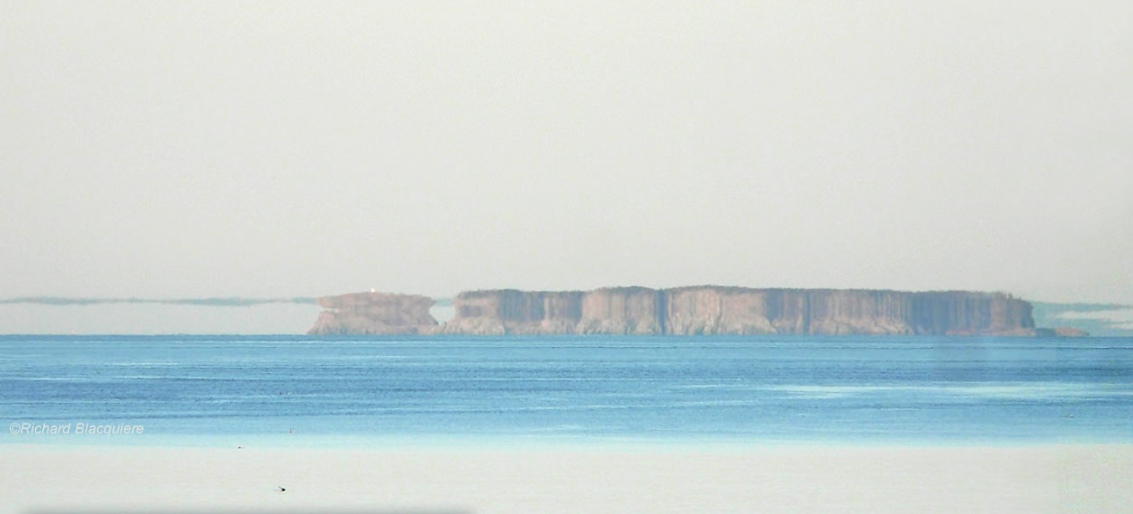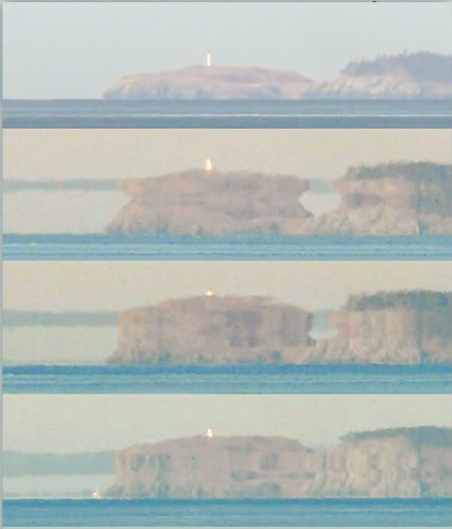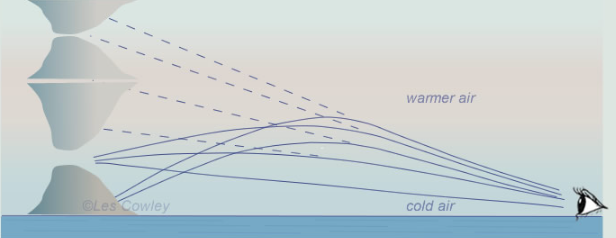OPOD - Fata Morgana, Bay of Fundy
Fata Morgana, Bay of Fundy: A Spectacular Mirage Phenomenon
Fata Morgana is a mesmerizing atmospheric optical phenomenon that occurs in various parts of the world, including the Bay of Fundy in Canada. This captivating mirage creates illusions of towering cliffs and surreal landscapes, transforming the ordinary into the extraordinary. Richard Blacquiere, an avid photographer, was fortunate enough to capture this enchanting spectacle from Point Lepreau, where the Wolves Archipelago loomed impossibly tall, reminiscent of the cliffs guarding Conan Doyle's Lost World.
The Fata Morgana observed by Blacquiere lasted for approximately two hours, with remnants lingering even longer. This prolonged display allowed him to capture numerous photos and witness the ever-changing nature of the mirage. The islands and distant mainland appeared to tower to such heights that the term "Fata Morgana" kept coming to mind. Blacquiere's experience of this ethereal phenomenon left an indelible impression on him, one that he will always remember.
In the normal view of the island, it appears as a typical image of the Wolves Archipelago. However, in the Fata Morgana mirage, the land is stretched upwards, creating towering cliffs that engulf everything except the top of the lighthouse on Southern Wolf Island. The mirage continuously transformed, with the islands alternately towering and collapsing, and the lighthouse changing from a mere white dot to an enormously elongated column. The cliffs themselves exhibited layers, suggesting the presence of multiple stacked mirage images, some possibly inverted.
While this particular mirage can be classified as a superior mirage, its pronounced vertical elongation and fantastical shapes are characteristic of a Fata Morgana. The name "Fata Morgana" is believed to have been derived from the appearance of the island palace belonging to Morgana, the half-sister of King Arthur, who was known as an enchantress.
The images captured by Blacquiere provide a fascinating glimpse into the complexity of Fata Morgana. In one sequence, spanning 31 minutes, it is evident that there are at least 5-6 stacked images, some inverted and others erect. Additionally, the sea surface to the left of the island appears to be miraged in the sky, forming dark bands. The lower edge of the mirage, resembling a choppy horizon, further adds to the mystique of this optical phenomenon.
To understand how Fata Morgana and other mirages form, it is essential to consider the role of temperature inversions. In a superior mirage, light rays from a distant object are refracted and bent downwards as they pass through temperature gradients caused by warmer air above cooler air. This bending of light creates the illusion of objects floating in the air, with some appearing erect and others inverted. However, Fata Morgana involves more complex temperature profiles that smear and merge multiple images vertically, resulting in the formation of cliffs and even architectural embellishments.
The Fata Morgana observed in the Bay of Fundy also showcases inverted images that are clearly visible, dripping downwards to meet the lower mirage images. This unique visual effect adds to the surreal nature of the phenomenon, as vertical cliffs and impossibly tall trees seemingly materialize out of thin air.
Fascinating and awe-inspiring, Fata Morgana continues to captivate both scientists and enthusiasts alike. Its occurrence in the Bay of Fundy serves as a testament to the remarkable beauty and complexity of atmospheric optics. By providing us with glimpses of otherworldly landscapes, Fata Morgana reminds us of the wonders that can be found right here on Earth, if we only take the time to observe and appreciate them.
Please note: This article has been automatically converted from the old site and may not appear exactly as intended.

Fata Morgana, Bay of Fundy, Canada
Richard Blacquiere captured this miraged view of the Wolves Archipelago from Point Lepreau. The islands loom impossibly tall like the cliffs guarding Conan Doyle's Lost World. The lighthouse on Southern Wolf Island at far left was ~26km distant. Long lenses are needed for most mirages and Richard used one of 500mm equivalent 35mm film focal length. He was 10-12m above the water level.
�I arrived at the .bird. Observatory in the morning to find a superior mirage of some islands and coast line to the west. Birds were nearly forgotten as I watched the view. I took dozens of photos. I kept an eye on the changing display which lasted for at least 2 hours. There were remnants that lasted longer. Other islands and the distant mainland towered to such heights that I kept thinking Fata Morgana. It was something I'll remember.�
The normal view of the island is the top image at left. In the mirage the land is stretched upwards into towering cliffs and engulfing all but the top the lighthouse. The mirage was ever changing. In the sequence at left the islands tower and then collapse only to tower again. The lighthouse alters from a white dot to an enormously elongated column. The impossible cliffs are layered � there are several stacked mirage images with some probably inverted.
In less extreme forms this would be a superior mirage. It still is, but the pronounced vertical elongation into fantastical shapes is typical of a Fata Morgana (1,2,3,4,5,6). The name is said to be derived from the appearance of the island palace of enchantress Morgana, half-sister of King Arthur.
All images ©Richard Blacquiere, shown with permission.


The top view of the island is un-miraged.
The lower image sequence covers 31 minutes.
There are at times at least 5-6 stacked images alternately inverted and erect.
To the left of the island we see the sea surface itself possibly miraged in the sky as dark bands.
Note the choppy 'horizon', the lower edge of the mirage.

Superior mirage formation ~ Light rays from a distant object are refracted and sent back downwards by passage across the density gradients of a temperature inversion, warmer air above cooler. Light rays curve towards colder air.
The downward rays appear to the easily deceived eye to come from objects floating in the air. Some of them are erect, others inverted. More details here.
A Fata Morgana is formed by more complex temperature profiles. They smear the multiple images vertically and merge them into one another to form cliffs and even architectural embellishments. Castles in the air..

Vertical cliffs and impossibly tall trees?
Inverted images are clearly visible. They drip downwards to meet the lower mirage images

Note: this article has been automatically converted from the old site and may not appear as intended. You can find the original article here.
Reference Atmospheric Optics
If you use any of the definitions, information, or data presented on Atmospheric Optics, please copy the link or reference below to properly credit us as the reference source. Thank you!
-
<a href="https://atoptics.co.uk/blog/opod-fata-morgana-bay-of-fundy/">OPOD - Fata Morgana, Bay of Fundy</a>
-
"OPOD - Fata Morgana, Bay of Fundy". Atmospheric Optics. Accessed on November 26, 2024. https://atoptics.co.uk/blog/opod-fata-morgana-bay-of-fundy/.
-
"OPOD - Fata Morgana, Bay of Fundy". Atmospheric Optics, https://atoptics.co.uk/blog/opod-fata-morgana-bay-of-fundy/. Accessed 26 November, 2024
-
OPOD - Fata Morgana, Bay of Fundy. Atmospheric Optics. Retrieved from https://atoptics.co.uk/blog/opod-fata-morgana-bay-of-fundy/.